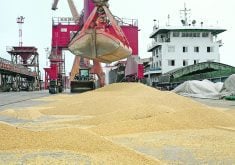A 42 percent reduction in Australia’s crop and drought fears in the United States might increase Canada’s exports
Growers might want to consider holding off on selling their wheat until the tail end of the crop year, says an analyst.
“A large part of the FarmLink strategy right now is to hold a block of wheat back into that time frame,” said Neil Townsend, senior market analyst with FarmLink Marketing Solutions.
“We think there will be a marketing opportunity in the last quarter of the marketing year.”
That is when he expects Australia will run out of crop to sell. Australian farmers grew 20.3 million tonnes of wheat in 2017-18, down 42 percent from the previous year.
Read Also

Defence investments could benefit agriculture
A bump in Canada’s NATO spending commitments could lead to infrastructure investments that would benefit rural areas
In addition to reduced production this year, there was a smaller-than-expected carryout from the 2016-17 crop.
The U.S. Department of Agriculture recently dropped its Australian 2016-17 carryout number by 2.73 million tonnes based on new statistics from the Australian Bureau of Agricultural and Resource Economics and Sciences.
It all adds up to reduced supply and lower exports for the 2017-18 crop year.
“With an Australian program that’s five or six million tonnes less than last year, Canada should pick up a portion of that. That should sustain us,” said Townsend.
The USDA is forecasting an even bigger drop with Australian exports falling by 6.6 million tonnes.
“That’s where we might pick up a few extra cargoes in the last three or four months,” he said.
Townsend also expects surging demand from U.S. millers toward the end of the 2017-18 campaign because of mounting concerns about drought in the spring wheat growing area for the upcoming crop year.
The latest map prepared by the U.S. Drought Monitor shows moderate to severe drought throughout much of the Dakotas and northeastern Montana and extending into southern Saskatchewan.
Millers could get nervous if drought conditions are still around come spring planting, which could prompt them to buy some 2017-18 Canadian spring wheat to offset the risk of a poor crop in 2018-19.
Townsend said Canadian wheat should be in high demand because it was an exceptional year for quality. Based on the Canadian Grain Commission’s harvest sample program, 77.5 percent of the spring wheat crop made the top grade and 91.3 percent made the top two grades.
“There should be buyers out there interested in Canadian wheat,” he said.
FarmLink is forecasting 16.7 million tonnes of wheat exports in 2017-18, up from 15.6 million tonnes last year. Agriculture Canada has a higher estimate of 17.2 million tonnes.
Bulk wheat exports through week 23 of the current crop year are 544,500 tonnes ahead of the previous year’s pace.
Townsend said exports will need to maintain the same pace to meet FarmLink’s forecast but they have been slowing of late due to intense competition from Russia.
Russia is poised to take over as the world’s leading exporter of the crop in 2017-18. The USDA is forecasting the country will ship 35 million tonnes of wheat. The next biggest competitor will be the European Union at 27 million tonnes.
Russian farmers harvested a record 85 million tonnes of wheat, up 17 percent from the previous year’s record.
Townsend said mid-tier Russian wheat is making big inroads into markets like Indonesia, Peru, Mexico, Nigeria and Bangladesh.
“They’re omnipresent now,” he said.
“They have gradually converted people over to their combination of quality and price.”
Russian exports usually slump in the November through January period due to bad weather conditions but it has been an unseasonably warm winter and with upgrades to port facilities, wheat is still being shipped.
















